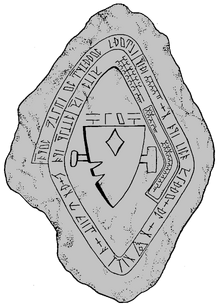
A typical dwarven runestone, as seen in Dwarves Deep
Runestones were stone slabs, with messages carved into them. These messages could be warnings, instructions, stories and accounts of events. They varied in shape and size, depending on the creator and time they were made. Some runestones even have magic enchantments installed into them.[1]
History
The ancient civilization known as the Adamant Kingdom of Xothaer, was home to numerous dwarven scholars. They recorded vast amounts of information on runestones. These records are still found today underneath the Cloud Peaks in various conditions, most shattered.[2]
Around 1370 DR the people of Iltkazar were famous makers of Runestones.[2]
Description
Runestones were large slabs of durable stone, usually about an inch thick. The had stories, instructions and accounts of events carved into one or both of their faces. Runestones were sometimes carved with images or runes in relief, and thus could have been used as seals or a temporary path markers when pressed into wet mud. Although extremely rare, there were runestones made of precious metals.[1]
Variations
Dwarven Runestones
Dwarven runestones were written in the Dethek script. They usually came in diamond or circular shapes. The text started at the edge and spirals into the center, where an illustration (such as a clan symbol) was usually carved. Due to this they are read from the outside edge to the center.[3]
Dwarven runestones were also used to mark graves, where an illustration of the dwarf in question would be carved into the center of the stone. Most Dwarven runestones were used as maps and clues to hidden hordes of treasure. These stones were some of the most sought after by greedy adventurers.[1]
Ward Tokens
Ward tokens were small slabs of stone, usually no bigger than a clenched fist, with magical properties. Ward tokens were used to reveal hidden doors, grant access to magical rooms and even travel across planes.[citation needed]
Ward tokens usually has a single rune or symbol inscribed into them as a clue to their purpose. Most runes did not appear to be magical until used, which made it difficult to determine their authenticity.[citation needed]
Durlag Trollkiller created various ward tokens as a means of navigating his dangerous, trap filled home, Durlag's Tower. Due to the adventuring popularity of the tower, many fake ward tokens were created by merchants to sell to adventurers. A few of the original ward tokens were in circulation but they were indistinguishable from the genuine ones.[4]
Known Runestones
- Delzoun Runestone: This runestone was said to explain the whereabouts of the legendary Hammer of Thunderbolts.[1]
- Thunderholme Runestones: These runestones granted access to the ancient city of Thunderholme. Although some were recovered, many were still lost or hidden.[5]
- Spawn Wars Runestone: A fragment of this runestone was discovered several hundred years after it was made. It detailed the events of the Spawn Wars.[6]
- Rockfire Disaster Runestones: In 1374 DR, Cragwarden Samiel Tussin discovered two runestones southwest of Trythosford at Itzcala. The two stones described the events of the Rockfire Disaster of 987 DR.[citation needed]
- Duergar Runestones: This series of runestones explained the history of Clan Duergar. They were discovered in 1383 DR by the crusaders of the Great Rift.[7]
- Axemarch Stone: This huge runestone stood 15 ft tall and 10ft wide. It rested on the highest peak of the Marching Mountains, commemorating the dwarven king Aldir Velms leading the dwarves to the mountain range as well as the founding of High High Shanatur. The rune dated this event as "day 75 of the 492nd year of the founding of House Axemarch".[8]
Appendix
References
- ↑ 1.0 1.1 1.2 1.3 Ed Greenwood (October 1990). Dwarves Deep. (TSR, Inc.), p. 11. ISBN 0-88038-880-3.
- ↑ 2.0 2.1 Eric L. Boyd (November 1999). Drizzt Do'Urden's Guide to the Underdark. Edited by Jeff Quick. (TSR, Inc.), p. 103. ISBN 0-7869-1509-9.
- ↑ Ed Greenwood, Jeff Grubb (August 1987). “Cyclopedia of the Realms”. In Karen S. Martin ed. Forgotten Realms Campaign Set (TSR, Inc.), p. 9. ISBN 0-88038-472-7.
- ↑ Ed Greenwood (1994). Volo's Guide to the Sword Coast. (TSR, Inc), pp. 90, 91. ISBN 1-5607-6940-1.
- ↑ Dale Donovan (January 1998). Cult of the Dragon. Edited by Julia Martin. (TSR, Inc.), p. 39. ISBN 0-7869-0709-6.
- ↑ Brian R. James, Ed Greenwood (September 2007). The Grand History of the Realms. Edited by Kim Mohan, Penny Williams. (Wizards of the Coast), p. 17. ISBN 978-0-7869-4731-7.
- ↑ Brian R. James, Ed Greenwood (September 2007). The Grand History of the Realms. Edited by Kim Mohan, Penny Williams. (Wizards of the Coast), p. 159. ISBN 978-0-7869-4731-7.
- ↑ Steven E. Schend (August 1997). “Book One: Tethyr”. In Roger E. Moore ed. Lands of Intrigue (TSR, Inc.), p. 21. ISBN 0-7869-0697-9.
